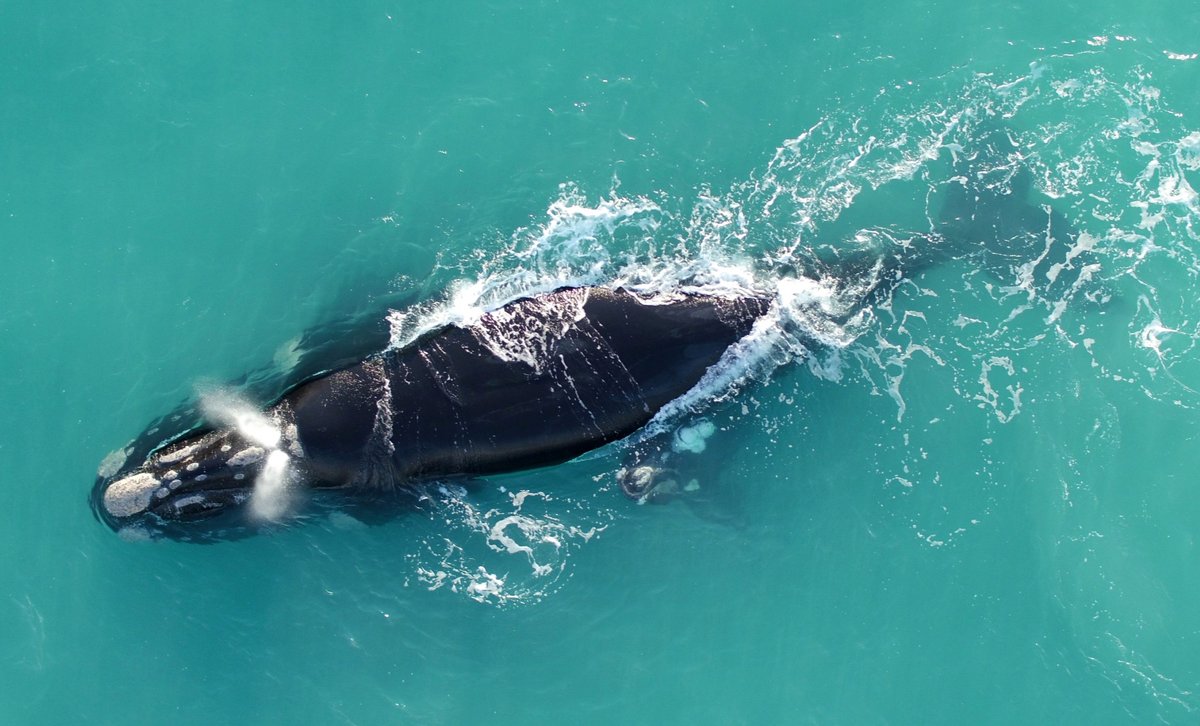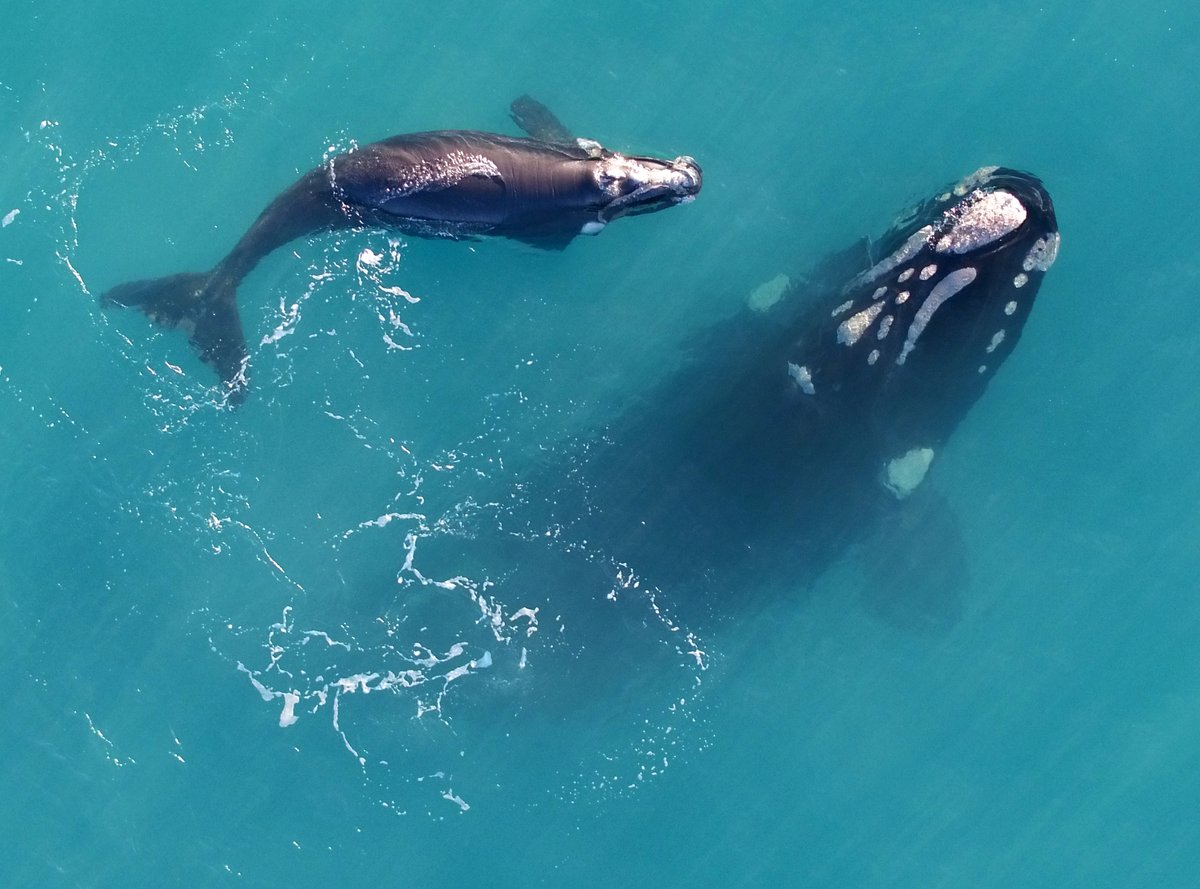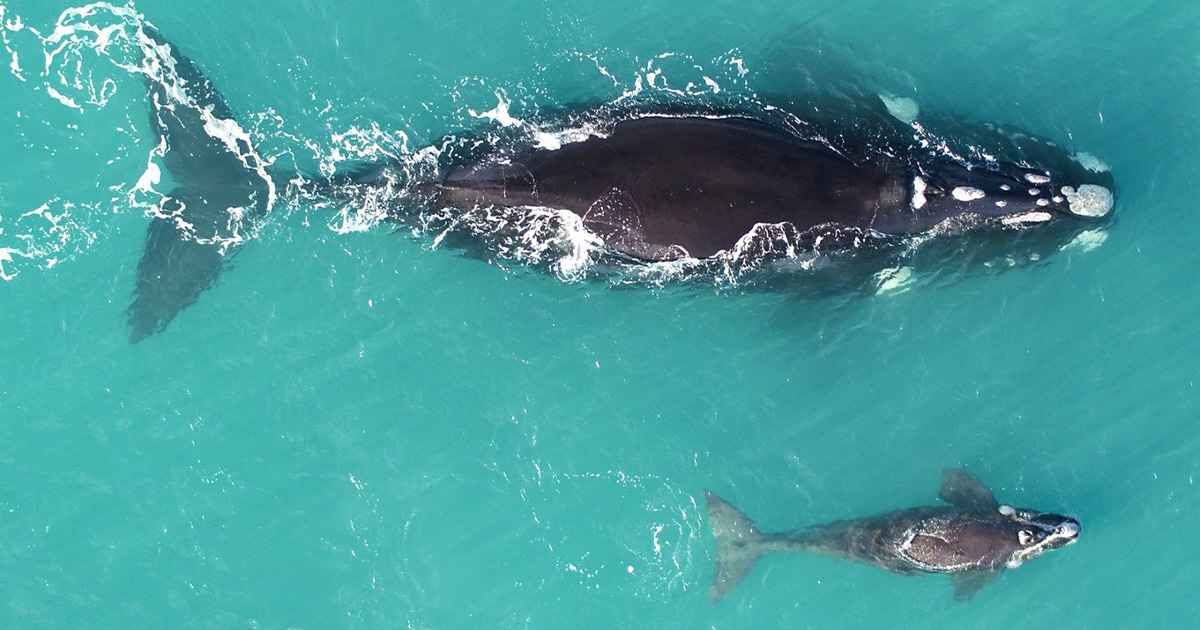In the month of June, when winter bites in the southern hemisphere and the sea around the Antarctic freezes over, right whales swim north. Many of them gather in the bay outside the town of Hermanus in South Africa.
Here, the warmer South African water is perfect for mating or raising newborn calves. However, there is no food for the whales, and all winter long, the right whale mothers use up their fat reserves to produce milk for their calves.
It is, therefore, extremely important that the whales eat a lot and fatten up in the cold waters around the Antarctic throughout the summer. But it seems there is not enough food. The whales arriving at the coasts of South Africa are thinner than they used to be.
This is the result of new research from Aarhus University. Since researchers started to measure right whales in the 1980s, the whales have become increasingly thinner. This is explained by Fredrik Christiansen, a senior researcher at the Department of Ecoscience at Aarhus University, who is behind the new results.
"Right whales are 25 percent thinner than they were in the 1980s. This is bad for the whale population because it means that newborn whale calves have a higher risk of dying. Fortunately, the right whales in the Southern Ocean are not endangered, but if this continues, they could become so," he says.
When the Ice Melts, Food Disappears
When winter comes, and the cows leave the Antarctic and swim north, they have to cope for several months without food. Several months in which they eat into the fat reserves they have built up through the warm and light summer season.
Throughout the summer, right whales swim around beneath the sea ice and open their mouths to take in seawater, krill, and water fleas. The baleen inside their mouth is a sort of a giant filter, and it filters the small animals from the salt water. This allows the whales to eat huge amounts of food without using a lot of energy.
But the large shoals of krill are shrinking—and this means that the whales can't fatten up before winter as they used to," explains Fredrik Christiansen.
"The shoals of krill live on phytoplankton, which thrive best in the cold waters around the Antarctic. Here—like plants on land—they transform sunlight into energy. Rising sea temperatures mean there is less phytoplankton, fewer krill and thus less food for the whales.
Instead, the whales forage for food further north, where there is another and less energy-rich form of krill.
"Further north, there's less food for these small crustaceans. Therefore, they're not as big and fat as the animals living beneath the Antarctic sea ice," he says.
How to Weigh a Whale
How exactly do scientists know that the whales have become thinner? Do Fredrik Christiansen and his colleagues lift the huge animals out of the water with oversized weighing scales? No, he explains. Instead, the researchers have invented a method to work out the weight of the whales based on photographs taken by drones.
 All photos used in this article have been taken by drones. It's the same photos that the researchers use to calculate the weight of the whales. (Image credit: Fredrik Christiansen)
All photos used in this article have been taken by drones. It's the same photos that the researchers use to calculate the weight of the whales. (Image credit: Fredrik Christiansen)
"Right whales like to lie flat on the sea surface. This makes them easy to photograph from above. When the drone has taken some photographs—and we know the height of the drone—we can calculate the size of the animal," he explains.
However, in order to know the weight of the whale, it is necessary to know the volume of the whale—not just the length and width. But because scientists like Fredrik Christiansen have observed many right whales rolling around on the sea surface over the years—and thereby have been able to measure their size—the scientists now know the relationship between length, width and volume of the whales.
"We calculate the volume using the drone photographs—and when we know the volume, we more or less know the weight. In this way, we can see that the whales have become thinner over the past 30 years—and that's serious. The weight of the mothers has a huge impact on their calves," he says.
Small and Weak Whale Calves
Thirty to forty years ago, the southern right whale had calved every three years on average. But this is no longer true, explains Fredrik Oscar Christiansen.
"In the 1980s, researchers observed that the right whales off the coast of South Africa gave birth to a new calf every three years. But because it's now difficult for them to fatten up during summer, this has fallen to every five years. This means that the population is growing significantly more slowly.
 The southern right whales used to give birth every third year, but because of the lack of food five years passes between every birth. (Image credit: Fredrik Christiansen)
The southern right whales used to give birth every third year, but because of the lack of food five years passes between every birth. (Image credit: Fredrik Christiansen)
And not only do the whale calves come more rarely. The calves born today are smaller and grow more slowly.
"The amount of fat on the whale mother is directly linked to how much energy she can give to her calf through her milk. When the mother is thin, the calf gets less energy and grows more slowly," he says.
The researchers have discovered that the northern right whales in the waters off Canada and the northern US are not growing quite as big as before. This is possibly because the calves are born smaller. According to the researchers' calculations, a whale born in 2019 will be one meter shorter on average when it is fully grown than a whale born in 1981.
"Small calves have a higher risk of dying. They're more vulnerable if a killer whale attacks."
Hunted Close to Extinction
Right whales were given their name because they were considered the "right" whales to catch. People began hunting the large whales as early as in the 14th century, and for hundreds of years, they were hunted fiercely in both northern and southern parts of the Atlantic.
Oil from the whales' fat was one of the most important sources of energy. Train oil, which the oil used to be called, became a fuel in lamps—both for indoors and for streetlights. The demand for train oil was also one of the most important reasons why Denmark colonized Greenland in the 18th century.
Around 1900, train oil was replaced by another more efficient energy source: crude oil. The black gold pumped up from the underground meant that whale hunting was no longer profitable.
The southern right whale is one of the species that benefitted from the end of whaling. For more than 100 years, the population has been allowed to grow large and healthy again. And this is not just good for the whales, but also for the entire Southern Ocean ecosystem.
Because the whales bring nourishment to areas of the sea with little food.
Extremely for the Marine Ecosystem
The sea around the Antarctic where the right whales come to eat has more life than any other sea on the planet. Despite the fact that the area only contains five percent of the Earth's seawater, 20 percent of all marine life lives in the area.
The many hours of sunshine in the summer, turbulent sea currents and the low temperature are perfect for teeming life.
The light makes marine algae grow explosively. The sea currents swirl the algae and nourishment around so that krill and plankton can gorge themselves. When full, the small crustaceans reproduce and form gigantic swarms. In some places, there may be as many as 35,000 krill in one cubic meter of water.
The right whales—and many other animals—stuff themselves with the abundance of krill, but unlike many other species, the whales migrate thousands of kilometers north to overwinter.
"The whales are extremely important for the parts of the sea where there is not much food. When the whales die, their huge bodies sink to the bottom. In the depths, they become food for a whole ecosystem of eel, sharks, crabs, lobsters, worms, and microorganisms," says Fredrik Christiansen.
So, if the whales disappear, it will have major consequences for many other animals.
"The whales are an apex predator. When an animal at the top of the food chain disappears, it has a cascade effect. Animals throughout the food chain will be affected if the whales are no longer there. From sharks to bacteria," he concludes.
Journal Reference:
- Els Vermeulen, Terriann Thavar, Maria Glarou, Andre Ganswindt, Fredrik Christiansen. Decadal decline in maternal body condition of a Southern Ocean capital breeder. Scientific Reports, 2023; 13 (1) DOI: 10.1038/s41598-023-30238-2



